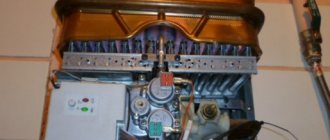Geometric features of the coil
There are a number of useful recommendations regarding the parameters of the moonshine still coil. It’s worth listening to them, since incorrect cooler dimensions can reduce
distiller performance and affect the quality of the distilled liquid.
Inner diameter. The larger the cross-section of the tube, the greater the contact area of the cooler walls with alcohol vapor and the lower the resistance. Accordingly, the condensation process proceeds faster. Optimal tube diameter? 8-12 mm.
Length. Before making a coil, you need to correctly measure the length of the tube. Recommended size? 1.5-2 m. With a longer cooler length, the area for condensation to settle increases, which automatically improves the cooling efficiency of alcohol vapors. On the other hand, the same indicator affects the transfer speed, since in a long coil the hydraulic resistance increases.
Wall thickness. A coil with thin walls has increased thermal conductivity. Accordingly, the condensation of vapors of the distilled liquid in it will proceed more intensely. However, when hot and cold environments come into contact, the thermal conductivity of such coolers decreases sharply, regardless of the tube material, internal diameter and size.
In addition, thin tubes break easily, require jewelry processing and wear out quickly. Therefore, for the manufacture of a coil, it is better to select tubes with a wall thickness of 0.9-1.1 mm.
Finally, the coil cooling system. It can be open, running on running water, or closed, when the required volume of water is poured into the tank before starting work. Structurally, closed systems are much simpler to implement. However, the efficiency of condensate cooling in such tanks is very low? The water heats up after only 2 hours, after which the process has to be interrupted.
Open cooling systems are much more convenient in this regard. The coil is constantly cooled, the condensation process is stable, and the distillate at the outlet is always cold. In addition, open systems do not require a large water tank. Accordingly, the design of the refrigerator is more compact, which increases the comfort of operation and storage of the moonshine still.
https://youtube.com/watch?v=BPhgP00DWBo
How to choose silicone tubes
Currently, silicone hoses can be purchased in various diameters (from 2 mm to 50 mm). Typically, diameters of 5,6,8 mm and a wall thickness of 1.5-2 mm are chosen for moonshine construction. Dimensions may vary depending on the design features, but choosing the required dimensions is not difficult.
You can buy a silicone hose at specialized retail outlets or online with delivery. There are resources where you can purchase all the necessary components along with the main equipment and auxiliary devices. It is advisable to use tubes in areas between the distillation column, a source of cold water and other devices, including between the distillation cube and the distiller.
The quality of the silicone hose depends on the manufacturer, but most companies sell proven products that meet the basic characteristics.
Since not everyone can determine whether a silicone hose is made of silicone or just PVC based on its external parameters, there is a certain technique that helps determine whether the product is silicone. To do this, you can set fire to the edge of the tube and if there is a characteristic pungent odor, black smoke, then the element is not silicone, which is characterized by light smoke and the formation of white ash. This method can be used if a hose is purchased on the market, but when purchased in a specialized store, medical laboratories, including an online resource, this verification option is not relevant. Such products comply with GOSTs and established standards.
This is interesting: Design and independent production of a distillation cube
Making a steamer/bubbler
A glass jar with a lid is usually used as the basis for a simple sump. For effective operation, its volume must be 10 times less than the corresponding tank parameter. An alternative option is made from stainless steel: it is stronger and more durable.
It is very important to connect the device correctly to avoid explosion
Instructions for making a sump bubbler from a can:
- Make 2 holes in the metal lid using an awl or drill, round the edges.
- Insert fittings with external threads into the holes so that the ends for the hoses are on the outside.
- Treat the joints on both sides with cold welding/hot glue to seal or seal with a silicone gasket.
- Connect a piece of silicone hose to one of the fittings on the inside of the lid so that in a closed jar its lower end is 2-3 cm above the bottom. From the outside, secure the end of the steam line coming from the cube.
- Connect the second fitting from the outside to the refrigerator using a tube, and screw the lock nut to it inside.
In order to turn a bubbler into a steamer, the hoses should be placed as follows: the incoming tube (from the cube) should be lowered into the jar 2-3 cm lower than the outgoing tube (to the refrigerator). Otherwise, the pressure in the device will exceed the permissible limit and will damage it.
The disadvantage of glass dry steamers is the absence of a drain valve, which complicates the removal of fusel oils from them. It is recommended to clean the container of impurities before collecting the main fraction (“body”). The use of several steamers in one apparatus is considered inappropriate, since it does not improve the quality of cleaning, but leads to losses of moonshine. The advantage of this design is that it increases the strength of the product. A more rational alternative is to connect a dephlegmator, which does a better job of pre-cleaning.
What should the coil be like?
There are several parameters that a truly working coil must meet, and the main one is the material.
- Material of manufacture
The further taste of the drink, prepared according to all the rules, will depend on this. The most important thing is that the material from which the pipe will be made should not enter into a chemical reaction with alcohol and release any harmful substances. The main types are aluminum, copper or stainless steel. Specialists use glass tubes, which allows them to personally control the process. But you definitely can’t make such a tube with your own hands; it’s easier to buy it at a chemical store.
The thermal conductivity factor is also important, which determines the rate of condensation. The most thermally conductive material is copper, followed by aluminum and only after stainless steel.
Interestingly, some moonshiners speak out against copper pipes, considering them toxic. We would like to remind you that in France, for example, all strong alcohol, including world-famous cognacs, is distilled in a copper still, and the taste only benefits from this.
The photo below shows a coil for a home moonshine still:
- Coil size
The distillation speed and the amount of product obtained depend on this parameter. An immutable rule applies here - the more points of contact with cold water, the faster the steam cools and condenses. However, due to the hydraulic connection increasing from turn to turn, the distillation speed is sharply reduced. The optimal length of the coil is 1.5 meters with a tube diameter of 10-12 mm.
- Location
To ensure that condensate drains by gravity and does not stagnate anywhere, it is recommended to use a vertical installation system. Horizontal or inclined, although not prohibited, reduce the amount of moonshine produced with an equal amount of mash.
- Cooling system
The simplest and most effective method of cooling is water poured into a container where the coil is immersed. Ice and cold air are also used as a cooling element, but their installation is quite difficult.
In addition, if possible, the container should be open so that warm water can be exchanged for cold. In a closed container, the condensation process is much worse and very often the moonshine at the outlet is already quite warm.
There is also a flow-through refrigerator where water circulates constantly. In addition to the fact that it cools the coil better, accordingly, moonshine is processed faster, it is also smaller in size. Thanks to this, the entire moonshine still turns out to be much more compact.
The process of making a coil for a moonshine still
The coil will be made from a copper tube. Let us remind you that you can also use aluminum, brass and even stainless steel tube. The length of such a tube is 1500-2000 mm, diameter 10-12 mm, wall thickness 1-1.1 mm.
Next, find the tank where the coil will be installed - a metal or glass container, the size of which determines the size of the coil. In general, once installed, it should occupy at least a quarter of the volume. If you don’t have any suitable container at hand, you can even use a piece of plastic pipe sealed at one end. The diameter of such a pipe must be at least 80 mm.
Drawing of a coil and housing for self-production
How to collect correctly
- Fill the tube very tightly with sand, salt or soda to prevent even the slightest deformation when bending. You should not freeze the water and try to curl the pipe, because when bending, the knee will heat up and melt the ice, which will cause deformation of the pipe.
- Close both ends of the tube with wooden or plastic plugs to prevent sand from spilling out.
- Find a round object with an equal cross-section over the entire height, 30-35 mm in diameter, and carefully wind the tube around it. You can bend it with pliers, but try not to deform the outer material. The pitch between turns should be 12-15 mm.
- Open both ends, pour out sand or salt and rinse thoroughly under running water.
- On the outside of the housing, insert pipes for water inlet/outlet.
- Place the coil vertically inside the container, secure the outlet channel to the outside, from where it will come out, fix it with sealant or cold welding, and make plugs on both sides.
This is what a fully assembled metal refrigerator looks like
The average heating power of the distillation cube is 3 kilowatts. With such indicators, the efficiency of the coil will be 4 liters of moonshine per hour. This volume is obtained from 30 liters of mash.
Materials for coils
Copper
An important advantage of a copper coil is its chemical inertness towards alcohol. It is necessary to understand that it is not the material itself that is inert, but the fact that it does not react either with alcohol itself or with alcohol-containing vapors.
During operation, a barely noticeable coating of copper oxide appears on the copper tube, which ends up in the finished product. But its quantity is so insignificant that it is impossible to even track it, let alone analyze the theoretical harm to health.
Stainless steel
Due to its resistance to corrosion, this material allows you to obtain the purest possible product. At the same time, it is difficult to independently curl the steel as required. In order to make the required number of turns, you will need a radial template or a pipe bender if you don’t have one, and a gas torch. The disadvantages are much lower thermal conductivity than copper and more significant weight.
How to bend a pipe without a pipe bender - video advice from the experts
Glass
Despite the fact that glass coils are used only in isolated cases, many are interested in the question of the feasibility of using such a material. Indeed, the resulting glass produces an absolutely pure product. BUT! It can only be prepared in a special workshop; it is difficult to connect with other elements of the moonshine still, and such a coil is very fragile.
Silicone tube
A good alternative for a coil, which also comes with certain pros and cons. The advantages include ease of processing and low price. This is a neutral material that does not react with alcohol, does not corrode and therefore does not transfer any foreign substances to the finished product. The disadvantages are that it is difficult to fix the shape, you have to use a wire frame and low thermal conductivity. Compared to the same copper coil, with a silicone coil the performance of the moonshine still is reduced by 25%.
Cooler for moonshine still
The design of any moonshine still includes 3 required elements:
- distillation cube;
- fridge;
- coil.
The units are connected to each other by a system of hoses through which water is discharged and supplied, and moonshine vapors are also processed.
The refrigerator is a storage or flow-type container in which a coil is placed. There is always water in the refrigerator, which cools the walls of the coil, thereby causing the release of condensate (moonshine) and its flow into the receiving container.
For a moonshine still, a high-quality coil means everything - the performance of the unit and the amount of moonshine depend on it.
How to make a cooler for a moonshine still
It is now clear that the main task of the coil is to instantly cool the vapors released when the mash boils and convert them into moonshine. The more contact and thermally conductive the coil is, the greater the amount of moonshine will be obtained in a certain unit of time.
The base of the coil is a pipe made of the selected material. We have already said earlier that in terms of flexibility, thermal conductivity and price, copper is the most suitable. We will use it to make a cooler with our own hands.
Other materials that may be suitable for the coil include silver, brass, stainless steel, aluminum and glass. Aluminum and stainless steel are available from this list, but both can only be processed under special conditions and on a machine.
What is needed to make a coil
The starting material is a tube with a diameter of 1-1.2 cm, a wall thickness of 1-1.1 mm and a length of about 1.5 meters.
If copper is chosen for the manufacture of the coil, it should be understood that it will need to be periodically cleaned of oxide deposits. This is a black coating that appears as a result of contact with air and sulfur. You can use baking soda or citric acid for cleaning. Dilute a tablespoon of one or another substance in a liter of warm water and soak the coil, depending on the degree of contamination, for 2-8 hours. Then you take it out and wash off all the plaque with a soft sponge.
How to curl a coil
To prevent the tube from bending and flattening, it should be filled with ordinary sand, hammering a wooden plug on one side.
Place the tube vertically and carefully pour in the sand, regularly tapping the tube on the table to compact the sand. When the tube is full, also close the other side with a plug so that the sand does not spill out when you curl it.
Use any pipe of suitable diameter for the base and fix it in a vice in a vertical position. Wind the copper pipe around the base so that there is a step of 0.5 cm between the turns and they do not touch each other.
How to make a cooler for a moonshine still - video
The coil is an important part of the moonshine still. Cooling and condensation of alcohol vapor occurs in it. This article will describe how to make a cooler and coil for a moonshine still with your own hands. What material and tube size to choose, what is the best way to cool.
Schemes of homemade moonshine stills and detailed examples of designs for do-it-yourself assembly.
What is a moonshine still and what processes take place in it when making moonshine?
A moonshine still, also known as a distillation cube, also known as a distiller, is a device used to obtain a strong alcohol-containing liquid by distilling mash with a lower alcohol concentration.
Thus, the moonshine still separates low-boiling components (ethyl alcohol) from heavy-boiling ones (water, fusel oils), as a result of which the concentration of alcohol in the final product (moonshine) increases and, accordingly, the concentration of water and fusel oils decreases.
Here, for example, is a diagram of a classic moonshine still with a coil:
In this scheme of a moonshine still, alcohol-containing mash is brought to a boil in a hermetically sealed container to which a coil is connected. Pressure cookers and milk cans (tanks, flasks) of 25 or 38 liters are most often used as containers. You can also adapt an ordinary saucepan for this purpose, ensuring that its lid is sealed, as here, for example. Having boiled, the mash vapors are discharged into a coil refrigerator (coil) connected to the apparatus, where, cooling due to the constant circulation of cold water outside the coil, they condense and flow into the prepared container in the form of moonshine.
The fact is that at the beginning of the boiling of the mash, mostly low-boiling components boil away from it, and as it boils, the concentration of high-boiling components that we do not need increases (and at this time not all of the alcohol has been extracted from the mash). And even at the beginning of boiling, high-boiling components are still present in the vapor due to evaporation, significantly worsening the quality of moonshine.
To minimize the consequences of this negative phenomenon, a reflux condenser is introduced into the circuit of the moonshine still (it is also a steam chamber, a still, and even a sump of a moonshine still). The reflux condenser is located between the distillation cube and the coil of the moonshine still and is a 1-3 liter container in which priority condensation of these heaviest boiling materials occurs. Here is a diagram of a moonshine still with a reflux condenser (sump):
There are also moonshine stills without a coil. Their only advantage is ease of manufacture (but not operation). As a rule, such moonshine stills are used by grandparents.
They are a fairly capacious pan (there are specimens of 50 liters or more) into which mash is poured, a container for assembling moonshine is lowered into the mash, which either floats on the surface of the mash or rises above its surface on a special stand.
A complementary basin is placed on top of the pan and cold water is poured into it. The basin is sealed around the perimeter of contact with the pan with dough or clay and thus plays the role of a lid and a cooler - a condenser at the same time.
The mash vapor comes into contact with the cold bottom of the basin and flows into the container above the mash. Although the drawing is not very good, I hope everything is clear.
Since all this is brewed together with mash, there is no question of any quality of moonshine. And considering that almost always the mash for moonshine is set to play in the same pan and is not drained from the yeast sediment - this is generally tinny (cracking of yeast, etc.).
This scheme has an even more primitive implementation: instead of a basin, a plastic film is stretched, sagging inside the pan, and cooling water is poured into this sag (sometimes with ice or snow, since the cooling efficiency here is not very high). The pan can be replaced with a bucket. Perhaps there is no more primitive moonshine still.
Here is a very simple and interesting moonshine still made from a kettle and a coil made from a silicone beer hose.
In conclusion, I will provide links to detailed instructions for assembling moonshine stills
Moonshine still design
There are many types of moonshine still. A typical design looks like this.
- A distillation cube containing the starting liquid, for example, mash. The cube is equipped with a thermometer.
- Steamer. In it, the steam from the distillation cube is condensed, and then the liquid is heated again, and the alcohol vapor enters the coil. Harmful substances remain in the steam tank.
- A cooler or condenser in which the incoming alcohol vapor is cooled and condensed, and then removed as a distillate.
The typical design can become more complex. The dry steamer may not be a separate element, but a built-in one. The cooler can be in the form of a column. A moonshine still with a column makes it possible to obtain stronger distillates for whiskey or cognac. There are devices with distillation columns that produce pure ethyl alcohol with a strength of 96 degrees.
Moonshine still of standard design
Manufacturing technology of a coil for a moonshine still
During production, it is important to choose a method for cooling the coil walls. As a rule, it occurs with the help of water, air or ice. The last two options are difficult to implement
The last two options are difficult to implement.
Are there two types of coils? open and closed. In the closed type, the coil itself is placed in a container that is filled with water in advance. This type is easy to implement. The disadvantages of this option: poor cooling and the output is warm moonshine.
The open type has a smaller volume, cooling occurs with running water and gives a greater heat transfer effect, which allows you to get cold moonshine at the output
In this case, it is important that water and moonshine move in opposite directions, that is, water? from bottom to top, this is called “counterflow mode”. It ensures uniform cooling of the coil tube throughout its entire length
Making a coil will require a tube made of copper, aluminum or brass; a product made of stainless steel with a length of 1.5-2 m, a diameter of 8-12 mm and a wall thickness of 0.9-1.1 mm is also suitable. It is first necessary to prepare the housing (reservoir) to place the coil in it. The size of the housing to choose will determine the diameter of the tube winding. A suitable option would be a plastic sewer pipe with a cross-section of 75-80 mm. For greater performance, the coil should occupy at least 20% of the tank cavity.
- Fill the tube with dry sand or soda; any other bulk material will also work. This is necessary to ensure that the tube does not deform during the winding process.
- The ends of the tube must be closed. To do this, you can use wooden pegs (chopics), clamp them tightly or solder them. A bolt needs to be welded on one side.
- Wind the tube around any cylindrical object with a diameter of about 35 mm, leaving a gap of 12 mm between the turns.
- After winding is complete, release the ends of the tube, remove the contents, and rinse the cavity with running water.
- Attach the coolant supply and drain pipes to the housing.
- Install the coil inside the housing and install plugs on both sides. You can ensure the tightness of the structure with glue.
The resulting design? refrigerator of a moonshine still, the productivity of which reaches 2-3 liters per hour with a power of 2.5-3 kW.
Which material to choose
The choice of material affects the safety and taste of the finished product.
Based on this, you can choose the following materials:
- Copper tube. Some believe that it is quite toxic. But this is a mistaken opinion. For many centuries, the French have been distilling strong drinks in copper distillers, which does not harm the quality of the finished product.
- Stainless steel. Compared to copper, the thermal conductivity of steel is 3-4 times lower and the exact manufacturer of stainless steel is often known. And for the coil, only food grades are applicable that can withstand high heat and do not enter into chemical reactions with alcohol.
- It is quite difficult to make a glass coil at home. If you choose this material, it is better to buy a ready-made product. At the same time, glass is the most non-toxic material with sufficient thermal conductivity.
- Nylon or polyethylene pipe? is considered chemically neutral, is a cheap material, most often used are tubes used for so-called “warm floors”. The only drawback? does not hold its shape well, this is solved by fixing the coil on the frame, often using ordinary wire for this.
Step-by-step manufacturing instructions
The connection process consists of several stages. You will need to do the following:
- Buy a tube that fits the parameters and bend it.
- Place the structure in a container of water. Attach tubes for water supply and drainage to the body.
- Install plugs in all holes and seal them tightly with glue.
Video: Step-by-step instructions for making a refrigerator for a moonshine still
Video: The simplest way to make a refrigerator
What is a refrigerator
In this module of the apparatus, the alcohol evaporated from the still is converted into a distillate: the vapors are cooled, condensed and flow into a receiving container with ready-made homemade strong alcohol. Without a good refrigerator, obtaining moonshine is associated with certain difficulties:
- part of the non-condensed alcohol is lost, leaving in a vapor state;
- the organoleptic quality of the final product (its aroma and taste) deteriorates;
- There is a danger of fire and explosion, since alcohol is a highly flammable substance.
The “appearance” and functionality of the cooler differs somewhat depending on the type.
Design and principle of operation
We will not consider an air cooler - it is unproductive and all the work of inventors in this direction has not yet given a stable result. And coolers in which cold water takes over the condensation function work approximately the same way, although they differ in design.
Here are the main details:
The sealed housing is cylindrical in the flow cooler. The supply of cold water and the removal of heated and waste water have been thought out. The bottom fitting is for cold water.
Attention. The flow cooler cylinder is installed vertically or at an angle of at least 45°. Only direct flow can be installed almost horizontally with a slight slope from the cube to the receiving tank
This rule is connected with the accumulation of alcohol in the coil during the distillation process. Unable to drain freely, it accumulates at the bottom of the coil turns. This is fraught with explosion
Only direct-flow ones can be installed almost horizontally with a slight slope from the cube to the receiving tank. This rule is connected with the accumulation of alcohol in the coil during the distillation process. Unable to drain freely, it accumulates at the bottom of the coil turns. This is fraught with explosion.
- Internal filling depends on the type. It could be:
- spiral wound coil;
- straight pipe;
- connection of several tubes inside the housing.
- Connecting tubes. Silicone or PVC tubes are used to supply water. With a still, the cooler is usually secured with stainless tubing.
Kinds
Do you still remember the “old-fashioned” cooler, consisting of a coil wound (sometimes literally from the pipe of a clamshell) located in a trough with cold water? The “archive” copies were replaced by other designs:
- Classic flow-through. This is a closed cylinder container with a coil inside.
- Direct flow. Instead of a coil, there is a straight tube inside.
- Non-flowing. Modern coolers of this type are produced in two varieties:
- with a cold water container with a built-in coil;
- without container. It is placed in a bucket, pan, etc. of suitable volume.
- Shell and tube. A more complex design, but it provides additional cleaning and strengthening of the moonshine.
Which is better?
The selection of a refrigerator depends on specific conditions. In a city apartment or private house, if there is a water supply, the best choice would be a flow-through design of the type you have chosen. The shell and tube type is considered the most productive.
For dachas and areas where the water supply is unstable or absent, a non-flowing one is perfect.
How to make a simple distiller from a saucepan?
To assemble the device you will need a minimum of parts, which will allow you to start manufacturing:
- Pan, volume can be from 7 to 40 liters. A lid is required.
- For the coil you will need a stainless steel or copper tube. Length – 2 m.
- Plumbing pipe with a diameter of 45 mm.
- A thermometer to make it easier to separate harmful fractions.
- Fitting, coupling, fum tape, epoxy glue.
- Parts for attaching the lid. They are chosen according to their capabilities, based on the situation.
Assembling the device begins with the refrigerator. First, make the coil itself. A copper or stainless steel pipe is prepared. You need to find a round blank in advance, which will then allow the coil to fit into the plumbing pipe. There should be up to 1 centimeter of gap left on both sides. The tube is closed on one side, and sand is poured on the other. The second side is also closed. Next, make a spiral; the distance between its branches should be no more than half a centimeter. There is no need to curl the entire length of the pipe. Leave about 4 centimeters on both sides so that you can connect the tubes later. Next, the sand is removed and the pipe is cleaned. Filling the pipe is necessary so that it does not lose its shape during bending.
Next, the coolant is collected. To do this, take a plumbing pipe; this is a more affordable choice. The length must be determined so that it matches the coil, it must fit. And a few more centimeters need to be left on top of this. You need to put fittings on the ends of the tube, but the pipe is cut off from them, leaving only a smooth surface. It is easier to put the fittings on by heating them over a fire. They are fixed with epoxy glue.
When the glue has hardened well, the pipe is drilled in the place where the fitting is located. Holes are made in both plugs. The tubes are pulled into them, then the plugs are glued with epoxy resin.
A steamer is not a necessary part of a home moonshine still. But its benefits are difficult to overestimate. It cleanses the distillate from harmful impurities and fusel. It's very easy to make. Take a jar with a lid. The lid should have two holes for tubes that supply and remove steam. In the container, the vapors are cooled and purified. The place of the steamer is between the distillation cube and the refrigerator.
How to clean
To obtain a quality drink, you need to regularly clean the coil. The frequency depends on the material of the spiral: copper - after each use, stainless steel - after 4-5 runs.
Method for cleaning the coil of a moonshine still:
- Take a thread or narrow synthetic twine with a length of 2 spirals and another 1 m.
- Tie the sponge tightly in the middle so that it hardly fits into the tube.
- Direct the thread into the coil to the maximum depth, keeping the rope at the level of the sponge.
- Place the device under running water.
- The liquid will carry the thread away and it can be taken from the other end.
- Pull the sponge through the tube. Rinse it and repeat the manipulations.
- Rinse the tube in running water.
When working with a copper coil, you first need to boil it in water with citric acid to remove oxides and sulfur compounds.
The stainless steel coil for a moonshine still can be cleaned with vinegar, but then it should be rinsed thoroughly with running water.
How the device works
It doesn’t matter whether you are an experienced winemaker or a novice amateur, in this case it is worth understanding the basic processes that occur during distillation. Knowing the main stages, you will be able to decide on the details of the moonshine still, as well as select the ideal configuration and ratio of all the main elements and parts
For ease of understanding, the process can be divided into several main stages, among which are:
- Before the start of the main process, the mash is collected in a special container and prepared for further processing.
- The first key step is heating the mash over a fire; for this, any container that is resistant to high temperatures can be used, since the process is usually carried out over an open fire.
- As a result, steam is formed, which must subsequently enter a system of special tubes (straight and curved options can be used).
- After passing through the system of connecting tubes, the alcohol vapor must pass into the refrigeration unit or coil, in which the condensation process will occur. The steam will precipitate in the form of liquid droplets and flow down the tube into the prepared container.
- After this, the drink collected at the exit can be consumed. If necessary, you can re-distill the moonshine to achieve a better result; the number of distillations depends on the type of moonshine still and the quality of assembly of all elements.
If we imagine the general process, then its essence lies in the separation of pure alcohol from mash (a mixture of alcohol, water and fusel oils, which is a low-alcohol drink). The method is based on a lower temperature of vaporization of alcohol compared to water, this allows you to get rid of water and increase the strength. Also, during the heating process, the alcohol fractions are separated and fusel oils are removed, which improves the quality and taste of the resulting drink.
Advantages of silicone hoses
The main doubts when choosing hoses for a moonshine still lie in the choice of a silicone element or a more economical analogue, namely a PVC product. The last option is quite risky, although more budget-friendly. Not every polyvinyl chloride will be able to withstand aggressive chemical compounds, high temperatures and other related factors that are present during moonshine brewing for a long time.
There is a possibility that the tubes will simply collapse during the process of preparing the drink, and under the influence of compounds and high temperatures, some of the released substances contained in the material will end up in the product.
If we compare silicone products with other types of hoses, in particular those made of PVC, we can highlight the following advantageous features:
- Wear resistance. Silicone is quite durable and even its repeated use in a moonshine system will not deteriorate its quality. That is why, if you plan to periodically produce alcohol, then it is better to pay attention to silicone tubes, which will withstand various influences due to their initial wear resistance;
- Resistance to high temperatures and changes. The material is able to withstand severe temperature changes, and the permissible intervals can range from -60°C, and the maximum value can reach +300°C;
- Resistance to chemical compounds, including quite aggressive ones. The production of alcohol is accompanied by the release of accompanying compounds. Naturally, they are not particularly chemically aggressive, but at high concentrations and constant contact they affect the walls of the system. Silicone tubes successfully cope with this effect and do not react with the compounds present;
- Anti-adhesive characteristics. Such parameters are important for food processes, since they imply the possibility of possible particles sticking to the walls and accumulating them on the surface, and also make it easy to clean the tubes themselves. If the tubes become clogged during the distillation process, the intensity of the removal or supply of water and product is disrupted, which will negatively affect the quality of the process. When blockages accumulate, it is sometimes necessary to interrupt the process and additionally blow out and clean the connecting elements;
- Bioinertness. In preparing a high-quality alcoholic drink, not only its strength and degree of purification are important, but also its taste characteristics, which can be ruined by ordinary pipes. High temperatures, components contained in the mash, as well as some other factors, can affect the structure of the hose material, which will lead to the release of a number of substances, but not when using silicone products. They are bioinert and do not react with other solutions. Therefore, silicone is successfully used not only in food processes, but also in medicine;
- Elasticity. This quality makes it possible to connect various elements of the system with each other without compromising cross-country ability. The elasticity of silicone tubes allows the products to be used repeatedly and their shape does not change, since even with deformation the material tends to return to its original configuration;
- No specific odor, including during operation. Even with prolonged use, there is no need to worry that a foreign odor will appear or the taste will change;
- Mechanical resistance. You can bend the hose, squeeze it, but it will not lose its functionality;
- Differences in size, section, color and other external characteristics. This allows the elements to be used for a variety of fittings and structures;
- The development of fungus is not supported, which is explained by the structure of the material;
- A convenient method of fastening, since the material tends to stretch a little, although there is also the option of using adapters;
- Long term. Compared to conventional rubber, the service life of silicone tubes is several times longer. The material is absolutely not inferior to PVC products, and even in some modifications exceeds the possible service life;
- Reasonable price. Compared with copper tubes, which have high practicality and corresponding cost;
This is interesting: Design and use of a moonshine still
The characteristics of silicone, which are its advantageous features over other materials, are explained by a special manufacturing technology.
Special organosilicon compounds are taken as the basis, which, together with other compounds, are transformed into silicone surfaces during temperature changes, chemical reactions and certain manipulations. The technology itself is considered one of the modern ones, some stages are being modernized, and as a result such highly sought-after material is being produced. It is actively used in the food industry, medicine, everyday life and in other various processes where a reliable and safe connection is necessary.
Coil refrigerator for moonshine still
Making a refrigerator coil for a moonshine still is no more difficult than making a shell-and-tube structure. The disadvantage of this product is the need to use a relatively large container to cool the alcohol vapor. A positive quality of the design is the distillation of alcohol without connecting the refrigerator to the water tap.
The suitable material for the heat exchanger in this refrigerator design is copper. To place the tube inside the container, it must be bent so that its shape resembles a spring.
We recommend reading:
How to make an incubator from a refrigerator with your own hands according to instructions and drawings
How to use a compressor from an old refrigerator
Instructions for making a smokehouse from a refrigerator with your own hands
In this case, the diameter of such a product should be slightly smaller than the width of the container in which the part will be placed. To avoid damaging the metal during the transformation process, dry and clean sand is poured inside, after which the ends are flattened. Copper is a soft material; to bend the tube well, just twist it around a perfectly straight cylinder. For this purpose, you can use a flat log or a piece of metal pipe. After the coil is completed, the deformed sections of the copper tube are cut off and the bulk material is removed. It would be useful, after carrying out this type of work, to thoroughly rinse the heat exchanger from the inside.
What material to choose for the coil
Regardless of whether you will purchase a ready-made “refrigerator” or if you want to experiment on your own, you need to understand the differences between materials and immediately decide what the element will be made of. The following types of coils are distinguished, made of such compounds as:
Silver. It is used quite rarely due to high production costs, although in terms of thermal conductivity and average service life, it is considered one of the best options; Copper. Good thermal conductivity is combined with an affordable price and practicality. The copper coil is used most often, since it can be made independently or purchased ready-made; Aluminum. Average heat transfer rates and low cost, but in terms of durability, aluminum products are inferior to copper or glass analogues; Stainless steel. If you plan to make a reliable element from something, then preference can be given to stainless steel. Such an element will cost more than identical coolers, but will last quite a long time and will not react with the alcohol solution over time; Glass
The material is absolutely neutral to alcohol vapors, which is important for high-quality alcohol, but not so much to mechanical stress and sudden temperature changes. It is easy to make a glass coil for a moonshine still with your own hands, or rather, purchase it in departments where laboratory attributes are presented or at specialized points for winemakers.
The choice of coils is quite wide, so finding the required diameter, required working surface and thermal conductivity parameters is not difficult. How to make a cooler with your own hands
First you need to decide on the material, since this will determine how long and often the coil will be used
When preparing alcohol at home, it is important that there are no interactions between the solution or steam. This must be taken into account, since high temperatures and aggressive environments, in the presence of surfaces that are not resistant to such factors, can ruin all the benefits of making drinks with your own hands
The technology for constructing a coil is practically no different in stages from the material used. By analogy, you can make a product from corrugated steel, copper or other surfaces. Since steel is one of the practical materials, although a little more expensive than copper, we can use its example to consider the manufacturing process:
Preparing the steel tube
It is important that it is food-grade, stainless, and has not previously been used in other chemical processes. You should focus on a diameter of 10 to 15 mm
As for the length, it is calculated relative to the desired cooler performance. On average it can be about 1.8 meters. Thickness – 1.5mm; Selecting a cylinder that will become the basis for winding the steel tube. The cross-section of the cylinder can also vary, but it must be at least 6 cm; Preparing for winding. You cannot simply bend the material relative to the cylinder, as it can be significantly deformed. To prevent this from happening, you need to make a seal, namely, fill the entire length of the pipe with clean, or better yet, calcined sand. On one side the pipe is sealed or you can simply insert a suitable plug, sand is poured in, and on the other side it is also clogged; Winding of a steel tube. The cylinder must first be firmly fixed; this can be done using a vice. The winding process itself must be carried out carefully and this will require certain physical efforts. Uncorking, pouring out sand.
It’s not difficult to make a device adapted for a moonshine still, but if you don’t want to waste time looking for suitable materials, then there is an option to use ready-made elements.
If the entire system is designed independently, then you will also need to correctly position the device and ensure tightness. There are options for horizontal, inclined or vertical placement. Each method has its own characteristics, which must be taken into account when collecting the entire moonshine system.









